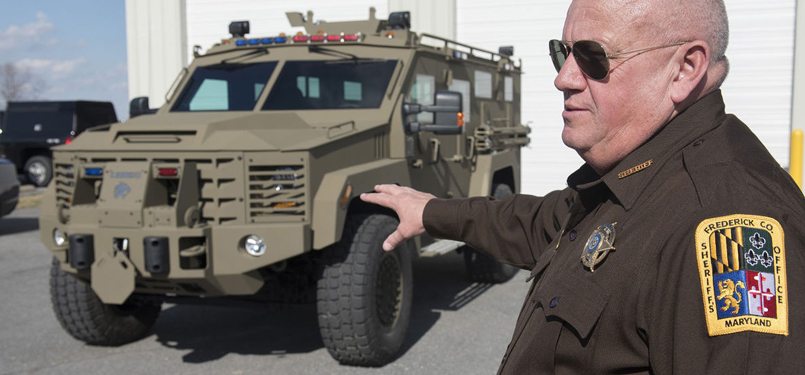Twenty years ago, Sheriff Chuck Jenkins wouldn’t have been convinced that an armored vehicle was essential for local law enforcement agencies.
In recent years, he said, that’s changed.
“I think it’s an absolute need for law enforcement today,” Jenkins said in an interview last week. “Look at today’s world. These active shooters, these terrorist situations — this stuff is real.”
A few days earlier, on Feb. 15, four members of the Frederick County Sheriff’s Office traveled to Pittsfield, Massachusetts, to pick up a brand new Lenco BearCat — a type of wheeled, armored truck used by various military and law enforcement agencies.
A week later, the BearCat was deployed for the first time, when 62-year-old Richard Harriday barricaded himself in a garage on West South Street. Harriday is accused of fatally shooting Zachary Winters, 28, at a nearby apartment building.
“Wednesday was a perfect example of how I envisioned that vehicle being used,” Jenkins said. “If one situation comes up where you need it, it’s money well spent.”
In total, the Sheriff’s Office spent $274,216 on the new BearCat, which was funded entirely by the department.
Reimbursement money that the Sheriff’s Office received for housing Immigration and Customs Enforcement (ICE) detainees covered $225,000 of the cost. The rest came from cash and other assets — such as vehicles — seized in drug arrests.
“I want people to know that the money came from drug dealers and illegal aliens,” Jenkins said. But even if the department hadn’t been able to pay for the vehicle, he said, he would have requested money from the county.
“This is a 25-year investment,” Jenkins added. “This vehicle will last for generations.”
The new BearCat was officially purchased in March 2016, after County Executive Jan Gardner approved a request from the Sheriff’s Office to replace an older Lenco truck.
The earlier armored vehicle was purchased from a military surplus website many years ago and no longer protected against modern ballistics, said Major Tim Clarke, the commander of the Administrative Services division for the Sheriff’s Office.
“Since we purchased that vehicle, the types of weapons being used and the capability of the ammo have actually exceeded a lot of those older models,” Clarke said. “We did a ballistics review and it just was not providing safety to our officers.”
Jenkins credits Sheriff John McMahon — leader of the San Bernardino Sheriff’s Department, in California — for convincing him to buy the BearCat. The two leaders met at a January 2016 National Sheriffs’ Association Conference in Washington, D.C., where McMahon discussed the 2015 mass shooting at San Bernardino’s Inland Regional Center.
His department was one of the first to respond to the attack, which left 14 dead and 22 seriously wounded, including one deputy.
“I was on the fence,” Jenkins said. “But after I heard him describe the incident and how his officers responded with regular vehicles and got shot all to hell, that really convinced me.”
Frederick police Chief Ed Hargis agreed with Jenkins’ assessment of the BearCat as a necessary resource for local police departments. In an emergency situation, he said, it’s crucial for officers to have fast access to heavy-duty equipment.
Hargis remembered one specific incident, in 1995, that highlighted the local need for armored vehicles. He was serving as police chief in Camden, New Jersey, and his officers responded to a subject who barricaded himself with an AK-47 rifle.
When his department called the Philadelphia police to borrow a truck, they were told it was out of service. The subject ended up fatally shooting two officers and critically wounding one.
“So, I’ve seen it firsthand, where that capability has been crucial,” Hargis said. He included $375,000 for an armored vehicle in the Frederick Police Department’s 2017 budget proposal, but ended up dropping the request.
Hargis said he didn’t resubmit the request in the department’s 2018 budget proposal, but could see a need for both agencies to have a vehicle.
“I always say two is one and one is none,” he said. “If we did ask for one, it would be down the line — maybe a smaller vehicle that could navigate city streets and alleyways.”
By Kate Masters
The Frederick News Post


